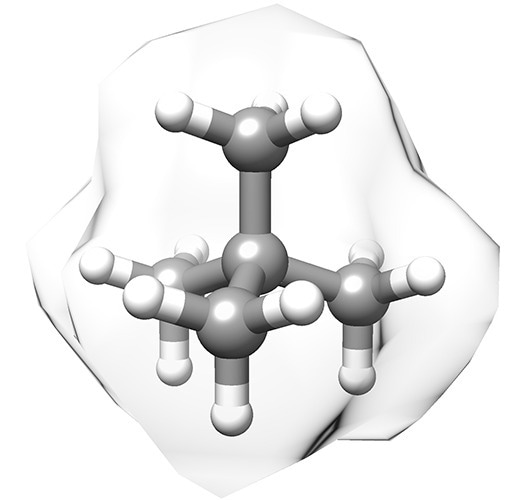Many medications contain what is referred to as a tiny molecule, which is primarily composed of carbon and is larger than water but much smaller than an antibody. However, if these molecules call for a quaternary carbon, which is a carbon atom bound to four other carbon atoms, then producing them is difficult.
 An image of tert-butane, the simplest quaternary carbon. Image Credit: Scripps Research
An image of tert-butane, the simplest quaternary carbon. Image Credit: Scripps Research
Scientists at Scripps Research have recently discovered a possible low-cost method of creating these complex patterns.
They have demonstrated that a single, low-cost iron catalyst may transform input chemicals into quaternary carbons. Their results were published in the journal Science. Drug developers may profit from this approach since it will make molecules more affordable and simpler on both small and large scales.
Quaternary carbons are ubiquitous across various areas of research—from drug discovery to material science, the synthesis of quaternary carbons, however, is a long-standing challenge in the field of organic chemistry, typically requiring numerous steps and relying on harsh conditions or less accessible starting materials.
Nathan Dao, Study Co-First Author and PhD Candidate, Scripps Research
Xu-Cheng Gan and Benxiang Zhang were the other Co-First Authors of the paper in addition to Dao.
Materials called catalysts are employed to quicken a chemical reaction's pace. A true “reaction soup” might occur when multiple catalysts are required to encourage a particular reaction and achieve the intended outcome.
Catalysts can be costly, they do not always respond as planned, and the more catalysts employed, the more waste is generated. However, the scientists at Scripps Research found that a single catalyst might fulfill several important roles.
A difficult chemical reaction often requires many interacting components, and a benefit of this work is it is incredibly simple.
Ryan Shenvi, Professor and Study Co-Senior Author, Department of Chemistry, Scripps Research
Using a cheap iron-based catalyst, the team found straightforward conditions to change two key kinds of chemical feedstocks, raw materials used to power machinery or industrial processes, into quaternary carbons: Carboxylic acids and olefins. These chemical feedstocks are very inexpensive and readily available.
Shenvi explained, “Similar reactions have been gaining traction lately, so this discovery was inevitable, the pieces were already in the literature, but no one had put them together before.”
Overall, the work emphasizes the continued importance of chemistry in creating contemporary technologies and medications. It was conducted in cooperation with the lab of Senior Co-Author Phil Baran, PhD, the Dr. Richard A. Lerner Endowed Chair in the Department of Chemistry at Scripps Research.
This work is yet another striking demonstration of the power of the collaborative atmosphere at Scripps Research to unearth new transformations that can have a dramatic impact on simplifying the practice of organic synthesis.
Phil Baran, Study Co-Senior Author, Department of Chemistry, Scripps Research
The National Institutes of Health, the National Science Foundation, Nanjing King, Pfizer, and Biogen funded the study.
In addition to Gan, Zhang, Dao, Baran, and Shenvi, the study's authors are Cheng Bi, Maithili Pokle, Liyan Kan, and Yu Kawamata of Scripps Research; Michael R. Collins of Pfizer Pharmaceuticals; Chet C. Tyrol of Pfizer Medicine Design; and Philippe N. Bolduc and Michael Nicastri of Biogen Inc.
Journal Reference:
Gan, X., et al. (2024) Carbon quaternization of redox active esters and olefins by decarboxylative coupling. Science. doi.org/10.1126/science.adn5619